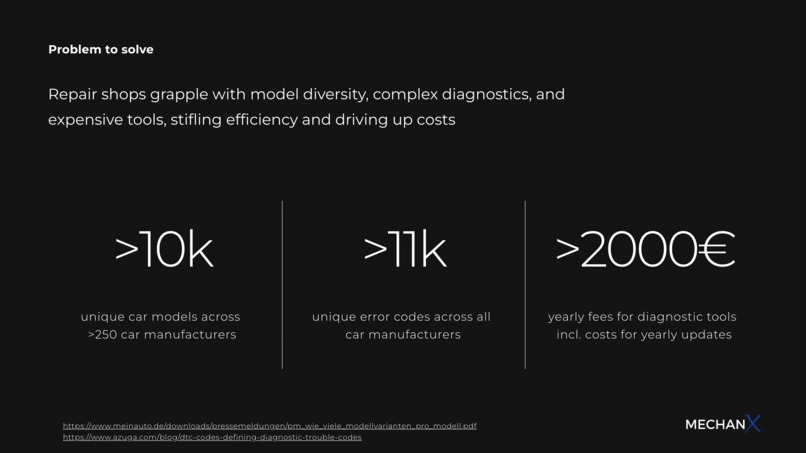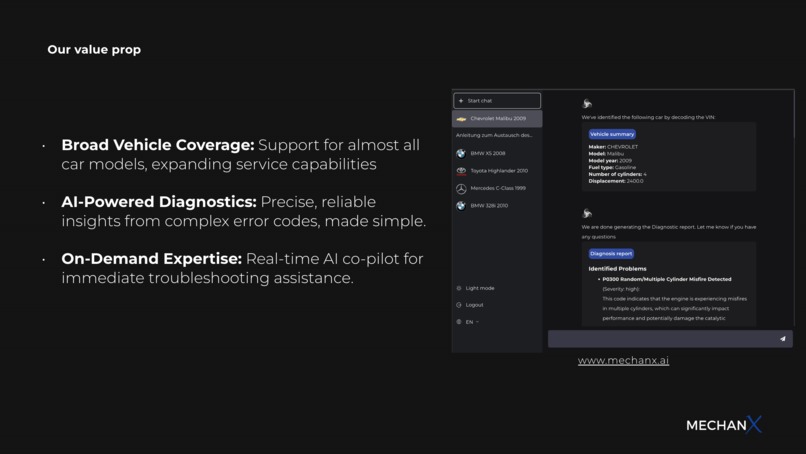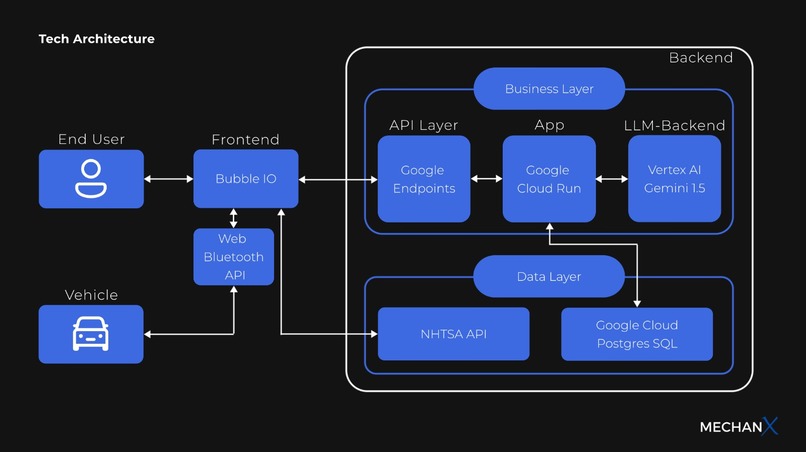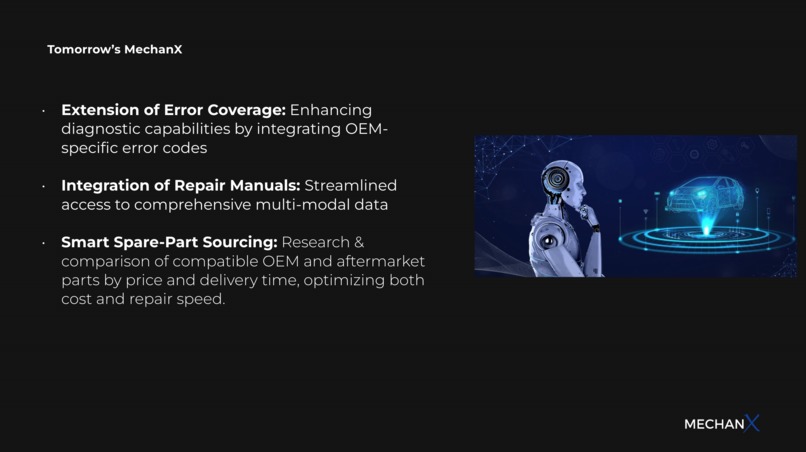Inspiration
The automotive repair industry is increasingly challenged by the extensive diversity of over 10,000 vehicle models and more than 11,000 diagnostic trouble codes (DTCs) as they can’t remember and analyze them all - once stored in the car. This complexity forces mechanics to rely on multiple expensive, brand-specific diagnostic tools, which not only inflate costs due to the need for multiple tools and frequent updates but also lead to inefficient diagnostics, misdiagnoses, and ultimately, reduced customer satisfaction. Mechanics struggle with accurate and timely analysis, which delays repairs and affects service quality across the industry, whereas repair shop owners struggle with training and retaining mechanics.
What it does
MechanX is an AI-powered diagnostic platform that revolutionises the way vehicle problems are diagnosed and repaired. Connecting to any vehicle via an OBD2 adapter, MechanX quickly retrieves and analyses Diagnostic Trouble Codes (DTCs). The platform enhances these codes with manufacturer-specific data to provide a detailed and accurate diagnostic report. This report includes easy-to-follow repair instructions tailored to the problems identified, enabling mechanics to resolve issues efficiently and accurately. In addition, MechanX provides a chat interface for mechanics to obtain additional information or clarification, ensuring they have all the necessary details to complete repairs successfully. By integrating large language models and comprehensive data analysis, MechanX significantly reduces diagnostic time and increases repair accuracy, improving overall workshop productivity.
How we built it
Building MechanX involved a strategic mix of innovative tools and robust technologies to create a seamless and powerful service. For the front-end, we chose Bubble, a versatile no-code/low-code framework that allowed us to quickly develop and deploy an intuitive user interface. This choice enabled rapid iterations based on user feedback, improving the overall user experience. On the backend, we used Google Cloud Platform (GCP) for its scalability and reliability. Using Terraform, we created an API over the Cloud Run service within a secure virtual private network. This custom API acts as a bridge, translating user requests into calls to Google Gemini. In addition, we used a PostgreSQL database to store an extensive library of DTC codes and all relevant service objects, ensuring that data management is both efficient and secure.
Challenges we ran into
We faced a number of challenges. As newcomers to the Google Cloud Platform (GCP), our first hurdle was mastering its suite of services, a critical step in realising the full potential of the cloud for our needs. Another major challenge was sourcing relevant and accurate data, such as the comprehensive details behind Diagnostic Trouble Codes (DTCs), which are essential for accurate diagnostics. Understanding car manufacturer specifics, including the intricacies of CAN bus communication and even the physical location of OBD2 adapters, was not always trivial.
Live testing our product proved invaluable, but also presented its own challenges. We partnered with over ten repair shops to test MechanX in real-world conditions, which not only allowed us to refine our tool, but also gave us a deep insight into the real needs of mechanics. This feedback loop was crucial in ensuring that our service best serves the users for whom it is designed.
Perhaps the biggest technical challenge was developing a reliable method of connecting a customer's browser directly to the OBD2 adapter. This connection had to facilitate the real-time retrieval of vehicle information and DTC codes. Overcoming these obstacles required innovative coding solutions and a deep commitment to creating a seamless, functional and user-friendly product. Each challenge provided a valuable lesson that ultimately improved the performance and reliability of MechanX.
Accomplishments that we're proud of
We are thrilled to share that our journey with MechanX has been filled with remarkable achievements that we take immense pride in. First and foremost, mastering the Google Cloud Platform to create a robust backend architecture was a significant technical game changer that laid the foundation for all other successes. The integration of comprehensive diagnostic data, including a detailed library of Diagnostic Trouble Codes, and tailoring our tool to the specific nuances of different car manufacturers represent crucial milestones that have greatly enhanced the functionality of our service. Our greatest accomplishment is the incredible impact MechanX has already made in the real world. The product has not only been actively tested by over ten repair shops, but it has also received overwhelmingly positive feedback from these early users. Mechanics love the accuracy, speed, and comprehensiveness of the diagnostics provided, validating our approach and highlighting the real-world efficacy of MechanX.
What we learned
A key lesson was the importance of selecting and mastering the right technology platforms; starting with Google Cloud Platform was a strategic choice that taught us the value of a robust and scalable cloud infrastructure. The effort to integrate detailed vehicle data, such as diagnostic trouble codes, highlighted the importance of comprehensive and accurate information for effective diagnostics. In addition, direct interaction and live testing with mechanics significantly influenced our product refinement process, underscoring the critical role of user feedback in evolving a product to meet real-world needs. Another learning point was the need to continuously feed our large speech models with targeted information to improve their accuracy and reliability in providing correct answers. We developed a deep understanding on how to prompt appropriately and how LLMs truely work under the hood. This has not only improved our service, but also deepened our understanding of artificial intelligence applications in real-world scenarios. Through these challenges, we have gained invaluable skills in problem-solving, adaptability and maintaining a user-centric approach to developing technology-driven solutions.
What's next for MechanX
Looking ahead, MechanX will be embarking on exciting new developments to improve and extend its capabilities. A key focus will be the refinement of our database to include more detailed information for vehicle-specific diagnostic trouble codes, ensuring even greater diagnostic accuracy. We also plan to introduce multimodal capabilities, such as speech support and image analysis. These features will allow mechanics to interact with MechanX using voice commands and to enter data by taking pictures, further streamlining the diagnostic process. In addition, we aim to provide more precise repair instructions to enable faster and more effective repairs. Another major enhancement will be the identification of requiews spare parts for our diagnosis report, making it a more comprehensive tool for repair workflows.
Built With
- artifact-registry
- bubble.io
- cloud-run
- docker
- gcp
- gemini
- google-compute-network
- javascript
- postgresql
- python
- sql
- sqlalchemy
- terraform
- vertexai








Log in or sign up for Devpost to join the conversation.